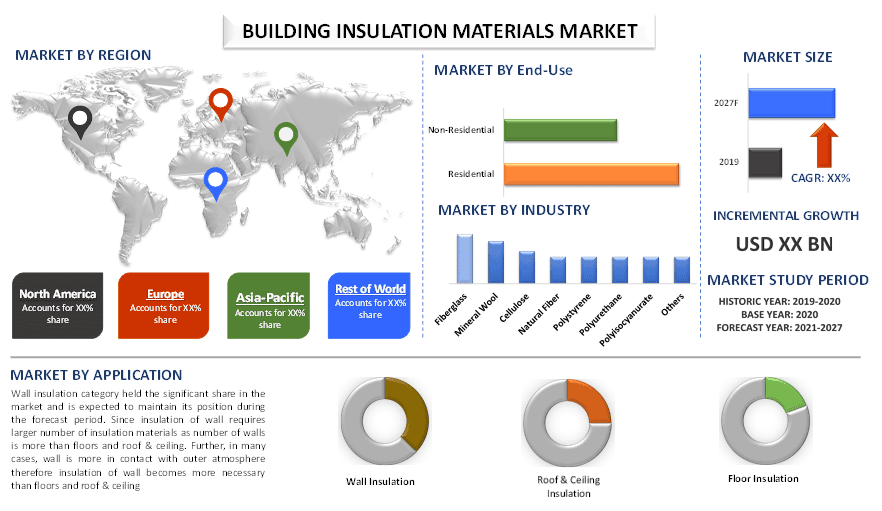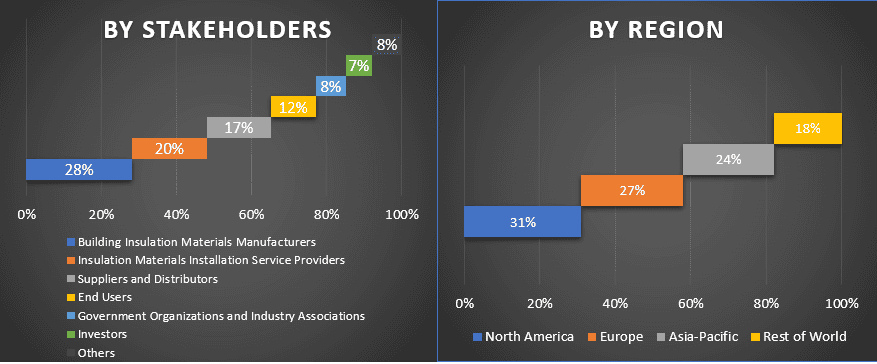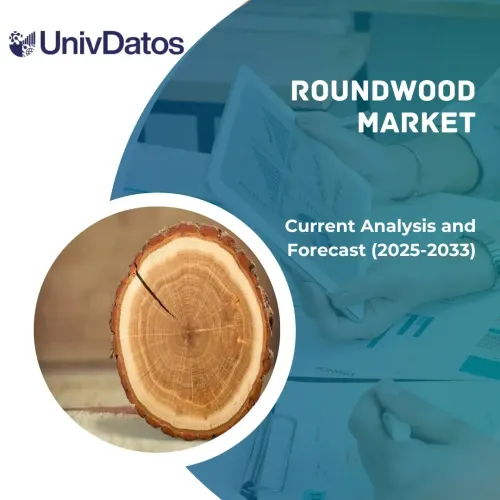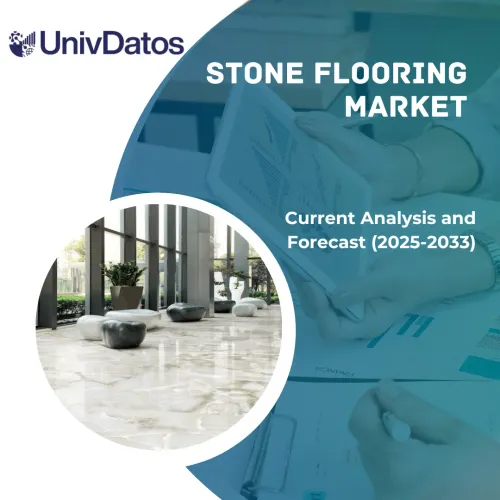建築用断熱材市場:現状分析と予測(2021年~2027年)
断熱材の種類(ブランケット、コンクリートブロック断熱材、硬質フォーム、断熱コンクリートフォーム、その他);材料の種類(グラスファイバー、ロックウール、セルロース、天然繊維、ポリスチレン、ポリウレタン、ポリイソシアヌレート、その他);用途(壁断熱、屋根&天井断熱、床断熱);最終用途(住宅、非住宅);および地域/国

世界の建築用断熱材市場は、予測期間(2021年~2027年)中に~4%の成長を示すと予想されています。 2020年~2030年の間、世界の建設市場は、主に発展途上国への投資増加により、著しい成長率を示すと予想されます。インドのような国では、人口増加に伴い、急速な都市化が進んでいます。そのため、増加する人口を収容するために、住宅および非住宅の建設活動が増加しています。例えば、オックスフォード・エコノミクスの調査によると、インドは2020年~2030年の間にインフラ建設活動において9.8%という最も高い年平均成長率(CAGR)を示すと予想されており、次いでインドネシアが8.2%のCAGRとなっています。建設活動の活発化により、断熱材の需要が増加すると考えられます。発展途上国では、断熱材の利点に関する認識が着実に高まっているためです。さらに、炭素排出量を抑制するための世界的な規制強化により、建築用断熱材の需要が促進されると予想されます。
レポートで提示される洞察
「断熱材の種類別では、2020年の市場ではブランケットカテゴリーが大きなシェアを占めました。」
断熱材の種類に基づいて、市場はブランケット、コンクリートブロック断熱材、硬質フォーム、断熱コンクリートフォーム、およびその他に分類されます。これらの中で、ブランケット断熱材は最も一般的で広く入手可能な断熱材の一種であり、バットまたはロールの形で提供されます。これは、柔軟な繊維、最も一般的にはグラスファイバーで構成されています。
「材料の種類別では、2020年の市場ではプラスチックフォーム材料が大きなシェアを占めました。」
材料の種類に基づいて、市場はグラスファイバー、ミネラルウール、セルロース、天然繊維、ポリスチレン、ポリウレタン、ポリイソシアヌレート、およびその他に分類されます。これらの中で、ポリスチレン、ポリウレタン、ポリイソシアヌレートなどのプラスチックフォームが市場の主要なシェアを占めました。これは、高い断熱抵抗(R値)、汎用性、強度、および寿命によるものです。
「北米は建築用断熱材市場で大きな地位を獲得しました」
建築用断熱材の市場採用をよりよく理解するために、市場は、北米(米国、カナダ、その他の北米)、ヨーロッパ(ドイツ、英国、フランス、スペイン、およびその他のヨーロッパ)、アジア太平洋(中国、日本、インド、オーストラリア、およびその他のAPAC)、およびその他の地域などの国での世界的なプレゼンスに基づいて分析されます。北米は、極端な気象条件、断熱材に関する高い認識、および人々の高い購買力により、世界の建築用断熱材市場で大きなシェアを占めました。
このレポートを購入する理由:
- この調査には、認証された主要な業界専門家によって検証された市場規模の算定と予測分析が含まれています
- このレポートは、業界全体のパフォーマンスの簡単なレビューを一目で提示します
- このレポートは、主要なビジネス財務、製品ポートフォリオ、拡張戦略、および最近の開発に焦点を当てて、著名な業界ピアの詳細な分析を網羅しています
- 業界で普及している推進要因、制約、主要なトレンド、および機会の詳細な調査
- この調査では、さまざまなセグメントにわたる市場を包括的に網羅しています
- 業界の詳細な国レベルの分析
カスタマイズオプション:
世界の建築用断熱材市場は、要件またはその他の市場セグメントに応じてさらにカスタマイズできます。これに加えて、UMIは、お客様が独自のビジネスニーズをお持ちであることを理解しているため、お客様の要件に完全に適合するレポートを入手するには、お気軽にお問い合わせください。
目次
過去の市場の分析、現在の市場の推定、および断熱材の将来の市場の予測は、世界中のその採用を確立および分析するために実施される3つの主要なステップです。徹底的な二次調査を実施して、過去の市場数値を収集し、現在の市場規模を推定しました。次に、これらの洞察を検証するために、多数の調査結果と仮定が考慮されました。さらに、断熱材業界のバリューチェーン全体にわたる業界専門家との徹底的な一次インタビューも実施されました。一次インタビューによる市場数値の仮定と検証後、ボトムアップアプローチを採用して、完全な市場規模を予測しました。その後、市場の内訳とデータトライアンギュレーション手法を採用して、業界が関連するセグメントおよびサブセグメントの市場規模を推定および分析しました。詳細な方法論を以下に示します。
過去の市場規模の分析
ステップ1:二次情報源の詳細な調査:
断熱材の過去の市場規模を取得するために詳細な二次調査が実施されました。年次報告書と財務諸表、業績発表、プレスリリースなど、および以下を含む外部ソースジャーナル、ニュースと記事、政府の出版物、競合他社の出版物、セクターレポート、サードパーティのデータベース、およびその他の信頼できる出版物。
ステップ2:市場セグメンテーション:
断熱材市場の過去の市場規模を取得した後、主要地域におけるさまざまなセグメントとサブセグメントの現在の市場洞察とシェアを収集するために詳細な二次分析を実施しました。レポートに含まれる主要セグメントは、断熱材、材料の種類、用途、および最終用途別です。さらに、世界中の断熱材の全体的な採用を評価するために、地域および国レベルの分析が実施されました。
ステップ3:要因分析:
さまざまなセグメントとサブセグメントの過去の市場規模を取得した後、詳細な要因分析を実施して、断熱材の現在の市場規模を推定しました。さらに、都市化の進展や建設およびインフラセクターへの投資の増加などの従属変数と独立変数を使用して、要因分析を実施しました。投資の増加、トップパートナーシップ、合併と買収、事業拡大、断熱材業界における製品発売を考慮して、需要と供給側のシナリオについて徹底的な分析が行われました。
現在の市場規模の推定と予測
現在の市場規模の決定:上記の3つのステップからの実行可能な洞察に基づいて、現在の市場規模、世界の断熱材市場の主要プレーヤー、および各セグメントの市場シェアに到達しました。必要なすべての割合シェア分割と市場内訳は、上記に記載の二次アプローチを使用して決定され、一次インタビューを通じて検証されました。
推定と予測:市場の推定と予測のために、利害関係者に利用可能なドライバーとトレンド、制約、および機会を含むさまざまな要因に重みが割り当てられました。これらの要因を分析した後、関連する予測手法、つまりボトムアップアプローチを適用して、主要地域全体でさまざまなセグメントおよびサブセグメントの2027年までの市場予測に到達しました。市場規模を推定するために採用された調査方法には以下が含まれます:
- 主要市場における断熱材の価値(米ドル)と採用率の観点からの業界の市場規模
- 市場セグメントとサブセグメントのすべての割合シェア、分割、および内訳
- 断熱材市場の主要プレーヤー。また、これらのプレーヤーが急成長市場で競争するために採用している成長戦略。
市場規模とシェアの検証
一次調査:主要地域の主要オピニオンリーダー(KOL)との詳細なインタビュー(主要幹部(CXO / VP、販売責任者、マーケティング責任者、運用責任者、地域責任者、カントリーヘッドなど)を含む)が実施されました。一次調査の結果が要約され、統計分析が実施されて、述べられた仮説が証明されました。一次調査からの入力は二次的な調査結果と統合され、情報を実行可能な洞察に変換しました。
さまざまな地域における一次参加者の内訳

市場エンジニアリング
データトライアンギュレーション技術を使用して、全体の市場推定を完了し、世界の断熱材市場の各セグメントとサブセグメントの正確な統計数値に到達しました。断熱材の種類、材料の種類、用途、および最終用途の分野におけるさまざまなパラメーターとトレンドを調査した後、データはいくつかのセグメントとサブセグメントに分割されました。
建築断熱材市場調査の主な目的
本調査では、世界の建築断熱材の現在の市場動向と将来の市場動向を特定しました。投資家は、本調査で実施された定性的および定量的分析から、投資判断の基礎となる戦略的洞察を得ることができます。現在の市場動向と将来の市場動向は、国レベルでの市場全体の魅力を決定し、産業参加者が未開拓市場を開拓し、ファーストムーバーの利点を享受するためのプラットフォームを提供します。調査のその他の定量的目標には以下が含まれます:
- 建築断熱材の現在の市場規模と予測市場規模を、金額(米ドル)で分析します。また、さまざまなセグメントとサブセグメントの現在の市場規模と予測市場規模を分析します
- 調査のセグメントには、断熱タイプ、材料タイプ、用途、および最終用途が含まれます
- 建築断熱材業界の規制枠組みの定義された分析
- さまざまな仲介業者の存在に関連するバリューチェーンを分析し、業界の顧客と競合他社の行動を分析します
- 主要国における建築断熱材の現在の市場規模と予測市場規模を分析します
- レポートで分析された主要地域/国には、北米(米国、カナダ、北米のその他)、ヨーロッパ(ドイツ、英国、フランス、スペイン、ヨーロッパのその他)、アジア太平洋(中国、日本、インド、オーストラリア、アジア太平洋のその他)、および世界のその他が含まれます
- 建築断熱材市場のプレーヤーの企業プロフィールと、成長する市場で持続するための成長戦略
- 業界の詳細な国レベル分析
関連 レポート
この商品を購入したお客様はこれも購入しました










